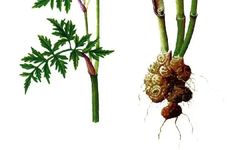 Chuanxiong (Ligusticum chuanxiong)
Chuanxiong (Ligusticum chuanxiong) 
Chuanxiong is the rhizome of the plant Ligusticum chuanxiong, which is cultivated artificially. It is harvested in May, cleaned of soil, sun-dried, and then the fibrous roots are removed. It is used either sliced raw or stir-fried with wine. The texture is firm, with small yellow oil spots scattered throughout. It has a distinctive fragrance and a bitter taste.
Summary from Ancient Texts 1Shennong Bencao Jing
1Shennong Bencao Jing
Indicated for wind stroke entering the brain, headaches, cold bi syndrome, muscle and tendon tension, traumatic injuries, and women’s blood stagnation leading to infertility.
 2Bencao Huiyan
2Bencao Huiyan
Chuanxiong ascends to the head, regulates menstrual flow, alleviates stagnation, and acts as a blood and qi medicine. It is often used in conjunction with Danggui (Angelica sinensis), not only for its blood benefits but also for its efficacy in regulating qi… Its flavor is pungent and warming, promoting movement without the stagnation of yin, and although it enters the blood, it can dispel all wind and regulate all qi.
 3Bencao Xinbian
3Bencao Xinbian
Chuanxiong can unblock blood stagnation, disperse external pathogens, treat headaches effectively, and relieve pain from traumatic injuries. This herb can serve as a monarch, minister, or assistant in formulas, but should not be used alone… If used solely to tonify blood, it may cause blood movement and lead to loss. If used solely for pain relief, it may stop pain but risk sudden death.
 Characteristics
Characteristics
This herb is pungent and warm, dispersing and moving qi and blood, ascending to the head and descending to the blood sea.It invigorates blood circulation, promotes qi movement, dispels wind, and alleviates pain.It treats pain due to blood stasis and qi stagnation, especially effective for cold conditions, earning it the title of “qi medicine in the blood.” It is best for headaches associated with wind-cold and blood stasis, and can also be selected according to symptoms for wind-heat, wind-damp, or blood deficiency, hence the saying, “Headaches are never without Chuanxiong.”
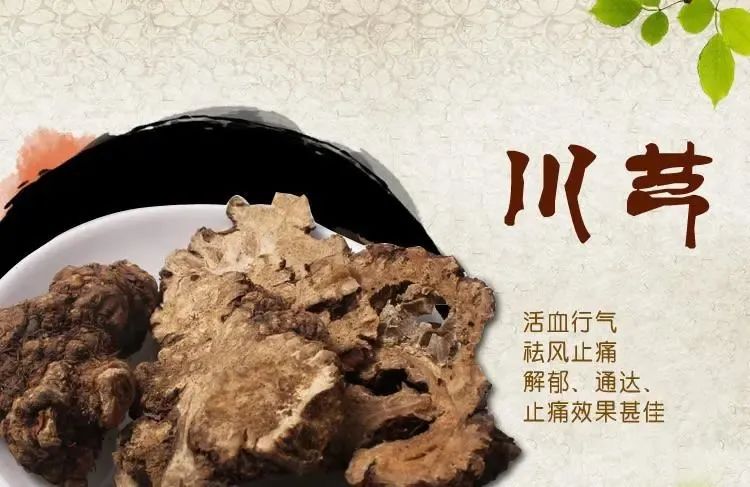
Indications
1. Pain due to blood stasis and qi stagnation.
This herb disperses and warms, invigorating blood and transforming stasis, while also moving qi and alleviating pain, serving as a “qi medicine in the blood,” thus effectively treating chest and abdominal pain due to qi stagnation and blood stasis.
For treating chest pain due to heart vessel obstruction, it is often used with Danshen (Salvia miltiorrhiza), Guizhi (Cinnamon twig), and Sandalwood; for treating flank pain due to liver qi stagnation, it is commonly paired with Chaihu (Bupleurum), Baishao (White Peony), and Xiangfu (Cyperus rotundus), such as in Chaihu Shugan San (Chaihu’s Liver-Soothing Powder); for liver blood stasis causing masses and stabbing pain in the chest and flanks, it is often combined with Taoren (Peach kernel) and Honghua (Carthamus tinctorius), as in Xuefu Zhuyu Tang (Blood Mansion Dispersing Stasis Decoction); for trauma and pain from bruising, it can be paired with Ruxiang (Frankincense), Moyao (Myrrh), and Sanqi (Notoginseng).
Chuanxiong is effective in “regulating menstrual flow and alleviating stagnation,” making it a key herb in gynecology, capable of invigorating blood and regulating menstruation, and can be used to treat various gynecological conditions.
For treating blood stasis leading to amenorrhea and dysmenorrhea, it is often used with Chishaoyao (Red Peony) and Taoren, as in Xuefu Zhuyu Tang; if due to cold congealing blood stasis, it can be paired with Guixin (Cinnamon heart) and Danggui, as in Wending Tang (Warming the Meridians Decoction); for postpartum lochia retention and abdominal pain due to stasis, it can be combined with Danggui, Taoren, and Paojiang (Fried ginger), as in Shenghua Tang (Postpartum Recovery Decoction); for irregular menstruation with early or delayed periods, it can be paired with Yimucao (Motherwort) and Danggui, as in Yimucao Shengjindan (Motherwort’s Golden Elixir).
2. Headaches, wind-damp pain.
This herb is pungent and warming, capable of “ascending to the head,” dispelling wind and alleviating pain, making it a key herb for treating headaches, whether due to wind-cold, wind-heat, wind-damp, blood deficiency, or blood stasis, and can be used according to symptoms, hence Li Dongyuan’s saying, “Headaches must use Chuanxiong.”
For wind-cold headaches, it can be paired with Qianghuo (Notopterygium), Xixin (Asarum), and Baizhi (Angelica dahurica), as in Chuanxiong Chajiao San (Chuanxiong Tea-Adjusting Powder); if paired with Juhua (Chrysanthemum), Shigao (Gypsum), and Jiangcan (Silkworm), it can treat wind-heat headaches, as in Chuanxiong San (Chuanxiong Powder); for wind-damp headaches, it can be combined with Qianghuo, Duhuo (Angelica pubescens), and Fangfeng (Saposhnikovia), as in Qianghuo Shengshi Tang (Qianghuo’s Wind-Damp Dispelling Decoction); paired with Danggui and Baishao, it can treat blood deficiency headaches, as in Jiawei Siwu Tang (Modified Four Substance Decoction); for blood stasis headaches, it can be combined with Chishaoyao and Shexiang (Musk), as in Tongqiao Huoxue Tang (Opening the Orifices and Invigorating Blood Decoction).
Modern Pharmacological Research
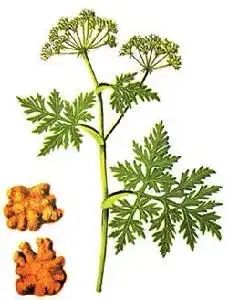
Chuanxiong contains volatile oils, alkaloids such as Chuanxiongzine, adenine, phenolic compounds (such as ferulic acid), lactones, as well as vitamins A, folic acid, sucrose, sterols, and fatty oils.
Modern pharmacological studies indicate that Chuanxiong can dilate coronary arteries, increase coronary blood flow, improve myocardial oxygen supply, and reduce myocardial oxygen consumption; it can dilate cerebral blood vessels, reduce vascular resistance, significantly increase blood flow to the brain and limbs, and improve microcirculation; it can lower platelet surface activity, inhibit platelet aggregation, and prevent thrombosis; the neutral components of ferulic acid promote uterine smooth muscle at low doses and inhibit it at high doses; the decoction has a sedative and hypotensive effect on the central nervous system in animals; and it has effects on promoting hematopoiesis, sedation, inhibiting various bacteria, anti-histamine, and choleretic actions.
 Case Study
Case Study
1. Patient Information
Liu Lina, female, 47 years old
2. Symptoms
Disease Overview: Migraine, first onset in July 2001, ongoing for 20 years.
Main Symptoms: Dull pain in the head before each menstruation, irritability, eye pain and light sensitivity after anger, vomiting.
3. Doctor’s Diagnosis
Liver Yang rising type migraine, treated with calming the liver and extinguishing wind, promoting circulation and unblocking meridians, using a combination of Xifeng Tongluo headache tablets and Phenacetin tablets.
4. Medication Method
Taking Xifeng Tongluo headache tablets, 3 times a day, 4 tablets each time, for 3 days; during menstruation, an additional Phenacetin tablet was taken, symptoms alleviated, and continued taking Xifeng Tongluo headache tablets. To date, only 3 boxes of Xifeng Tongluo headache tablets have been taken, and there have been no headaches for 2 months.
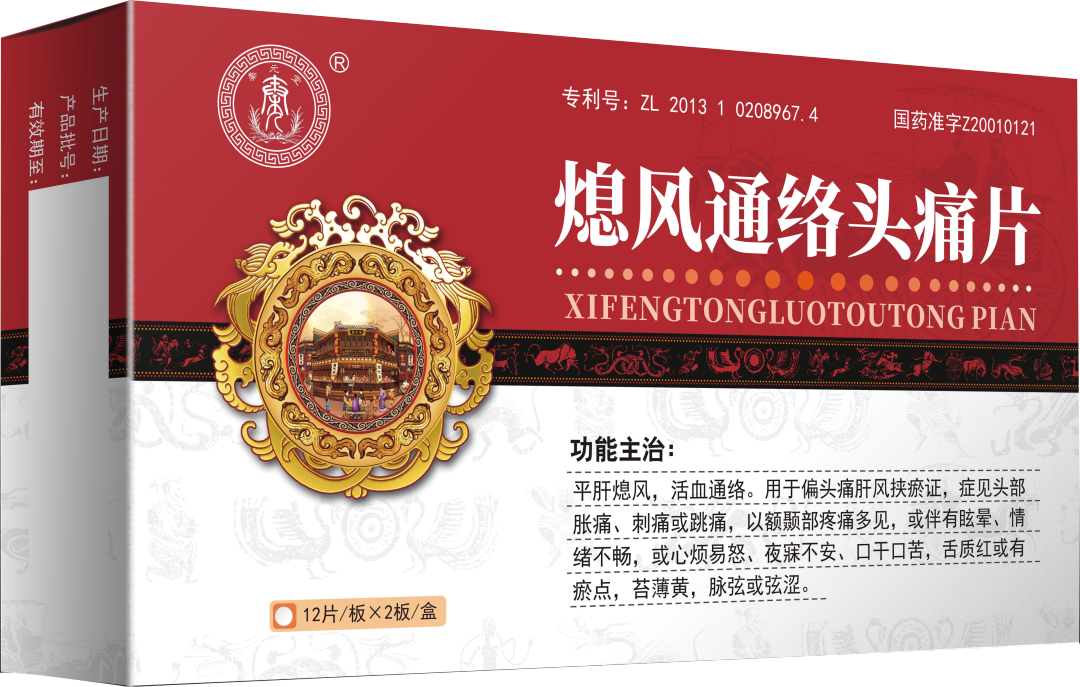
5. Follow-up Treatment
The patient repurchased a course of Xifeng Tongluo headache tablets.
【Note】Source: Doctor from the Xiaqiantou Health Clinic in Haiyang, Shandong
Analysis Analysis
Analysis
This 47-year-old woman has suffered from regular premenstrual headaches for 20 years, typical of liver yang rising type migraine, with irritability, accompanied by vomiting and light sensitivity. After taking Xifeng Tongluo headache tablets for 3 days, her symptoms were alleviated, and the analgesic effect was excellent. After taking 3 boxes of Xifeng Tongluo headache tablets, she has not experienced headaches for 2 months, indicating a root treatment of her migraine.This differs from Western medicine, which can address headaches but does not treat the root cause, allowing patients to remain symptom-free for two cycles.
The monarch herb in the Xifeng Tongluo headache tablet formula, Chuanxiong, is a guiding herb for the Taiyang and Shaoyang meridians, capable of directing the medicine upward to the head, effectively dispelling wind and alleviating pain, significantly improving the patient’s headache symptoms. Additionally, Chuanxiong is effective in “regulating menstrual flow and alleviating stagnation,” addressing the patient’s premenstrual headaches caused by endocrine disorders.
Classic Recipes

1. Chuanxiong Duck Stew: 10g of Chuanxiong, 20g of old ginger, half a duck, soy sauce, salt, cooking wine, sugar, etc. Old ginger is cleaned and sliced, duck meat is cleaned and cut into pieces; heat oil in a pan, add old ginger to sauté until fragrant, add duck pieces and stir-fry until slightly browned, add water, soy sauce, sugar, salt, cooking wine, and Chuanxiong, cover the pot, and simmer on low heat for one hour until the duck is tender. This dish can dispel wind and alleviate pain, invigorate blood and promote qi, effective for women with blood deficiency and dizziness.
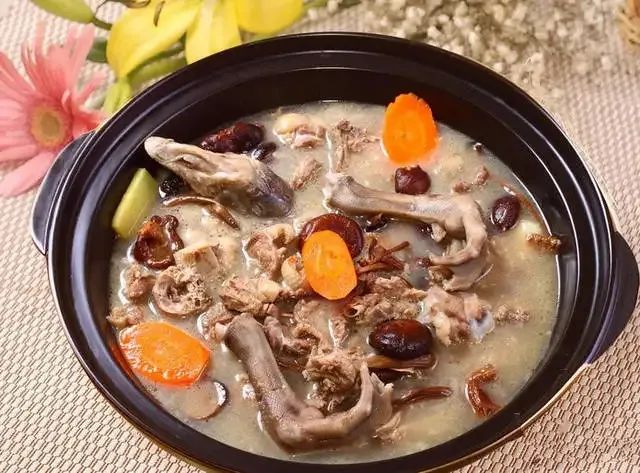

2. Chuanxiong Boiled Eggs: 6g of Chuanxiong, 2 eggs. Clean the eggshells, wash the Chuanxiong, soak for 10 minutes, place Chuanxiong and eggs in a pot, add appropriate water, boil until the eggs are cooked, remove the eggs, peel them, and return them to the pot, simmer on low heat for 40 minutes, then eat the eggs and drink the soup. This dish can promote qi and invigorate blood, used for dysmenorrhea due to qi stagnation and blood stasis, starting to consume three days before menstruation.
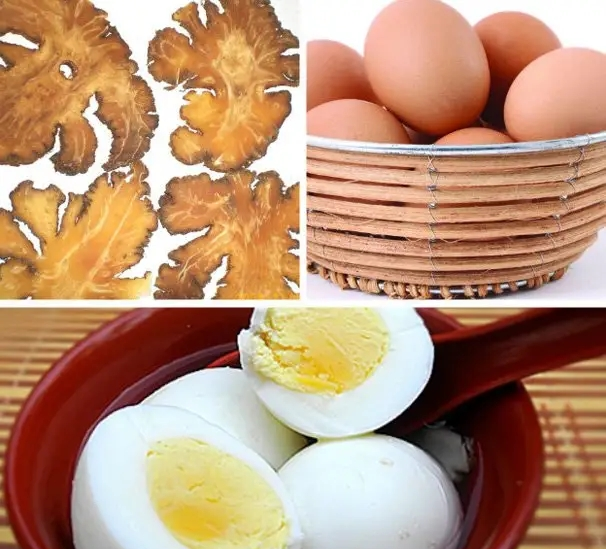 Usage Precautions
Usage Precautions
Use with caution in cases of yin deficiency with excess heat, excessive sweating, heat excess with no stasis, and in pregnant women.
Chuanxiong is incompatible with Shan Zhu Yu (Cornus), Langdu (Radix Gentianae), and should not be used with Nitrate, Talc, or Huanglian (Coptis).

